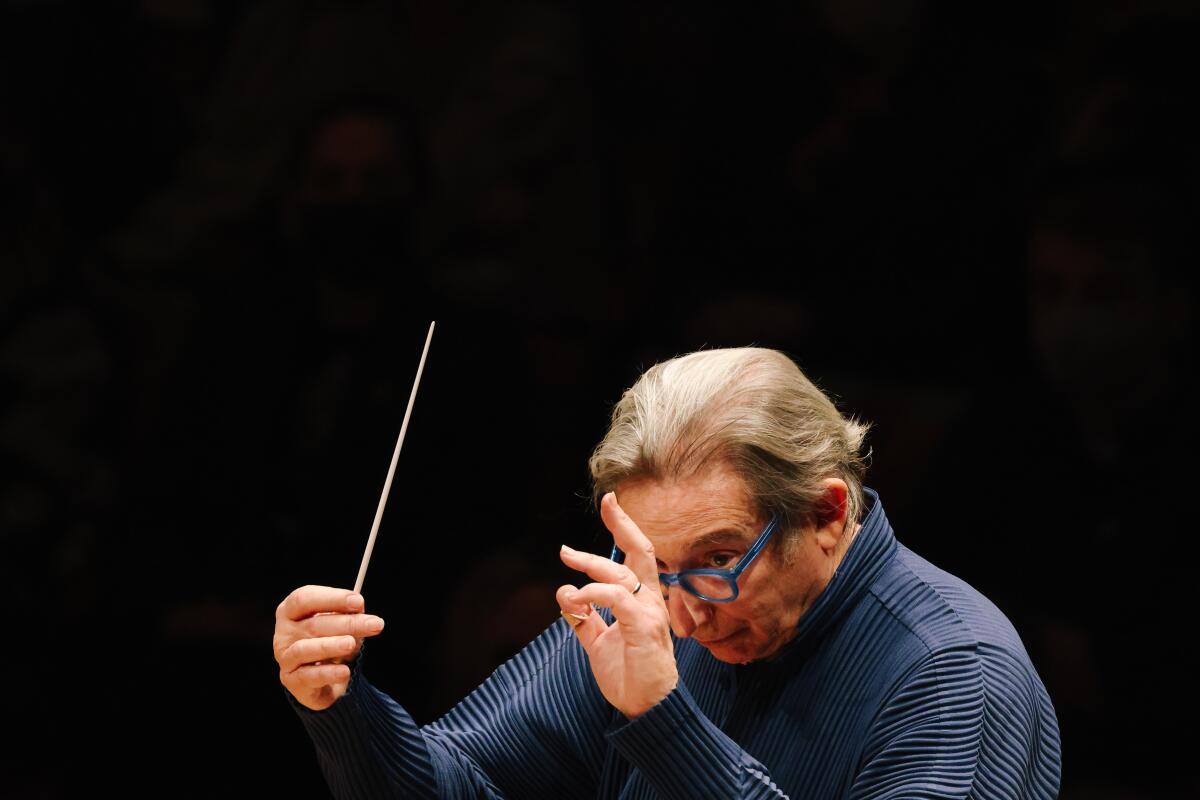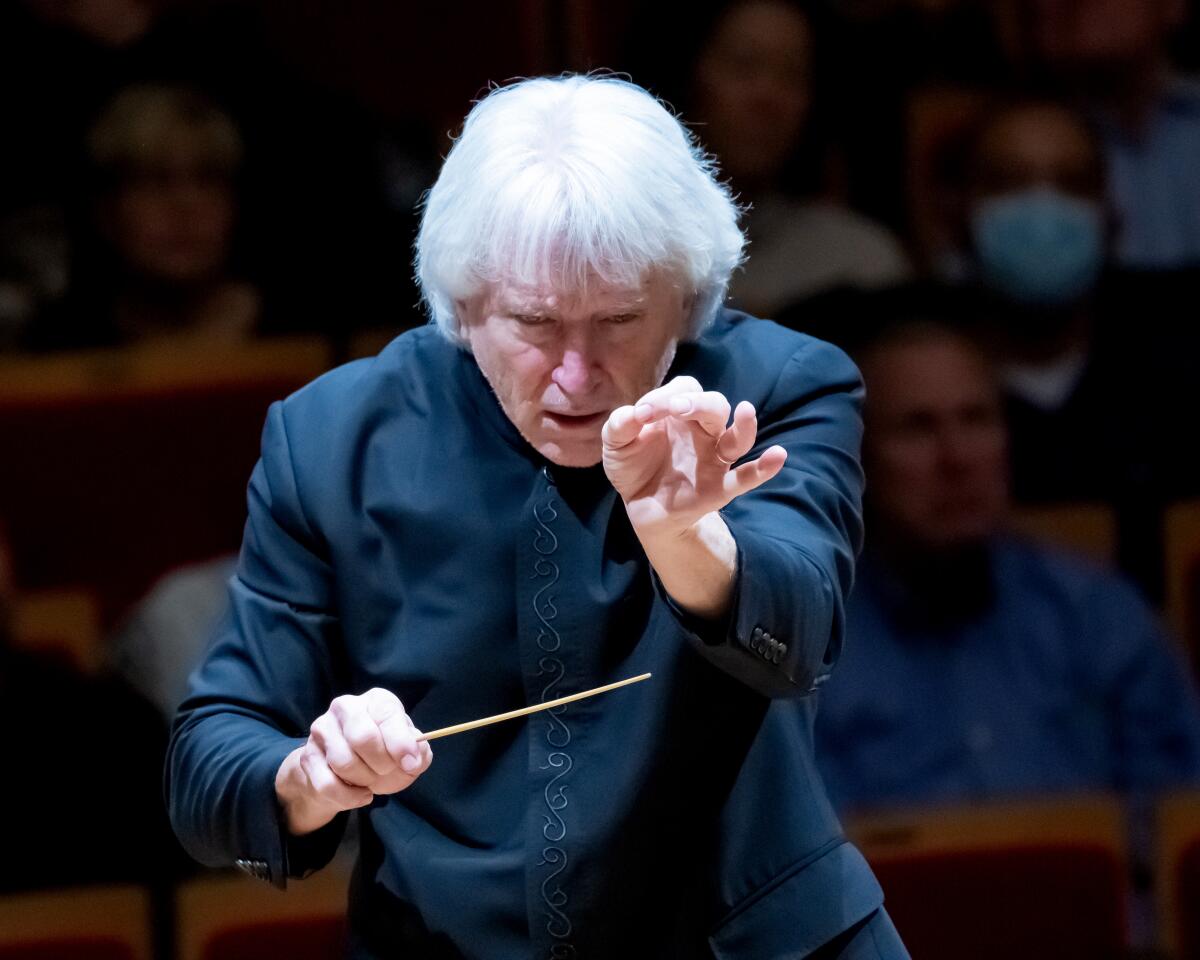Review: Mahler’s storied Ninth Symphony reaches revelatory new depth in two major L.A. performances

- Share via
Mahler’s Ninth Symphony, the last work he completed and his most personal, does and does not go gentle into the good night. He wrote it following the death of his young daughter and after learning of his heart disease diagnosis, which turned out to be fatal. The result is an abstract symphony that contains his deepest and most enduring last thoughts.
“Death has, on placid cat paws, entered the room,” I wrote of the fantastic effect Michael Tilson Thomas achieved when he began a memorable performance of this Ninth with the San Francisco Symphony, at Walt Disney Concert Hall in 2005.
Many years later in Disney, this last Sunday afternoon, Tilson Thomas conducted Mahler’s Ninth with the Los Angeles Philharmonic, ending the second of his two weeks with the orchestra. No cat’s placid paws this time. The symphony begins like life itself does. First, a small hint in the cellos emulate a tiny heartbeat barely heard. A melody gradually evolves, note by note in the strings. A horn responds, fondly looking on at new life. Tilson Thomas savored all. His tempo was more patient than it had been 18 years earlier. The orchestra, simultaneously transparent yet extravagantly luxuriant, produced a richly textured sound with such presence that you felt like you could reach out and touch it.
At 107 minutes, it was an unusually slow performance, but one allowing full Mahler time for extreme swings of emotion, from a ravishing smelling of the roses to outbursts of untempered angst. Tilson Thomas showed unflinching patience, always gently guiding Mahler back to profound peace.
There are as many ways to perform and listen to the Ninth as there are performances and listeners. Again, like life itself and like only the most significant and meaningful art can convey, the symphony has an essence too mysterious and momentous to be fully revealed. It can never be taken lightly, and in my experience the L.A. Phil never has.
Although labeled the Columbia Symphony for contractual reasons, the L.A. Phil players recorded the Ninth in 1961 led by Bruno Walter, who had premiered the symphony the year after Mahler’s death a half-century earlier. That recording is said to have launched the modern Mahler revival.
The first L.A. Phil Mahler 9 (and my first, as well) in 1969 was a solemn performance by the British Mahlerian John Barbirolli a few months before his death. Carlo Maria Giulini’s 1975 performance was so moving that it generated false rumors that the Italian conductor must, himself, have been dying.
Zubin Mehta and Simon Rattle produced vital, life-affirming Ninths. Esa-Pekka Salonen’s progressive Ninth brilliantly revealed just how much Mahler’s last testament was also a new map for where music might (and did) go in the 20th century. An audacious 29-year-old Gustavo Dudamel began 2011 by conducting his first Ninth in his second season as L.A. Phil music director and then boldly took it on his first European tour with the orchestra.
Tilson Thomas has now added something new and different that cannot be put into words. It almost didn’t sound like an interpretation. He let Mahler be. That is not to say that Tilson Thomas didn’t impose his will or that he left his ego in his dressing room. His was not only an expert display of conducting, but also a demonstration of what might be called his loving gaze of Mahler in all his magnificent contradictions.
The symphony is often represented as one of the most revealing portrayals of the psychological process of finding peace, as all that is put together in the symphony, its very life force, finally comes to its natural end while slowly diminishing in silence. Not a silence, though, of nothingness, but rather one of somethingness, the equivalent of white light that contains all colors. Mahler becomes, at the end, one with the universe.
The weekend proved exceptional, Mahler Ninth-wise, in another way. Just as the L.A. Phil had at Disney, the Pacific Symphony at the Renée and Henry Segerstrom Concert Hall devoted its three weekend concerts to Mahler‘s Ninth as well. Attending the Saturday-night performance made possible the rare opportunity to catch two major Mahler Ninth performances in less than 24 hours.

The Orange County orchestra may not have quite the resources of the L.A. Phil (no orchestra in America does), but its music director, Carl St.Clair, has been a devoted Mahlerian throughout his 33 years as music director of an orchestra he elevated to significance. And he happens to be on a Mahler 9 kick himself. Besides being a music director in Costa Mesa, he also is one in Costa Rica, where he serves as principal conductor of the country’s National Symphony Orchestra. He closed that orchestra’s 2022 season with the Ninth. Next, on Jan. 27, St.Clair will once more conduct the Ninth with the USC Thornton Symphony, of which he is also the principal conductor.
The Pacific Symphony performance offered an entirely different perspective on Mahler. St.Clair introduced the symphony by describing it as a voyage of suffering, from realization to reflection to rejoicing in life to resignation. He led it not from inside Mahler but rather as an outside observer, showing us how Mahler felt rather than having us feel how the great composer felt.
This was a forceful performance. The sound had power. The climaxes were explosive. The instrumental solos in the L.A. Phil purveyed a wonderful sense of freedom within a whole. The Pacific Symphony impressed by how its solos stood out. Everything was theater. The middle two movements, full of lively dances in the first and carnival-esque burlesque in the second, became orchestral showpieces.
By placing a large video screen over the stage, the Pacific Symphony added close-ups of the players and conductor, further adding to the theatrics. At the end, the camera stayed on St.Clair for a full minute of silence, his face contorted in grief, taking in the sheer momentousness of what had happened, holding off the applause. The sentimentality worked, stopping just short of becoming maudlin. This was a shattering performance that then came to a distinct end. We could then go back out into the rain.
Tilson Thomas didn’t speak to the audience. While St.Clair’s heart was comfortably and even impressively on his sleeve, there was no reading of Tilson Thomas’ mind, as he himself is suffering, as Mahler was when writing the Ninth, from a life-threatening disease. At the end, he simply stopped. No dramatic moment of silence. Nothing more to say. No sentimentality. The universe continues with its own business. All that was left was for Tilson Thomas to show his warm appreciation of the orchestra, which had played with what can only be called love. That the warmth carried over to an awestruck audience (there was hardly an empty seat) was unmistakable.
In the end, Tilson Thomas’ once-in-a-lifetime Ninth Sunday afternoon was in a class, and in a place, of its own. In Judaism, it would be called, for those who heard it and those who played and those who will hear it in the future (microphones hung over the stage), a mitzvah — a divine good deed.
More to Read
The biggest entertainment stories
Get our big stories about Hollywood, film, television, music, arts, culture and more right in your inbox as soon as they publish.
You may occasionally receive promotional content from the Los Angeles Times.











